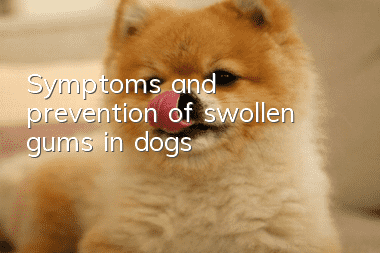Symptoms and prevention of swollen gums in dogs

Dogs with bad teeth will be very painful. Although dog gingivitis is a relatively common disease, this disease can actually be prevented in daily life. Next we will explain prevention knowledge.
Pembroke Welsh Corgi
Symptoms of swollen gums in dogs
1. Oral hygiene
After a dog has eaten food and has poor oral hygiene, the food remaining between the teeth will provide a breeding ground for bacteria. After a large number of bacteria multiply, they will form soft tartar, plaque and even calculus on the tooth surface, which will induce gingivitis.
2. Malformed teeth
If your dog has deformed teeth, it will greatly increase the incidence of gingivitis. Therefore, owners of this type of pet dog should pay more attention to the oral hygiene of their pet dogs.
3. Other factors
Endocrine disorders, vitamin C deficiency, nutritional disorders and some other systemic diseases can also cause gingivitis in pet dogs. Among them, endocrine disorders are the main ones.
4. Symptoms
The main symptoms of gingivitis are redness, swelling, bleeding, and pain at the gum line. In some cases, the inflammation will slowly destroy the gums and tooth supporting tissues, forming an abscess. If it continues to develop, it will invade the hard tissue and produce periodontal inflammation.
5. Bleeding gums
Gum bleeding is often the main symptom of gingivitis in pet dogs. It often occurs when biting hard objects. Occasionally, spontaneous bleeding may occur.
6. Gum color
Normal gums are pink, but when suffering from gingivitis, the free gums and gingival papillae turn deep red or dark red. This is due to congestion and proliferation of blood vessels in the gum connective tissue.
Prevention and treatment of swollen gums in dogs
1. Stone related
Dog gingivitis and dog dental calculus are closely related. If we reduce the occurrence of dog dental calculus, we will reduce the occurrence of dog gingivitis to a great extent:
2. Teeth cleaning
Let your dog develop the habit of brushing teeth from an early age, and reducing dental plaque will reduce the incidence of dental calculus: Qualified owners should brush their dogs' teeth at least once a week.
3. Remove remaining teeth
Remove excess teeth and reduce double dentition. During the tooth replacement period, pay more attention to the dog's tooth replacement, provide hard food to promote tooth replacement, and remove excess teeth if necessary.
4. Daily management
Giving your pet dog a hard and appropriate chew or large bone every day is equivalent to brushing or cleaning your pet dog's teeth.
5. Regular inspection
According to the recommendations of professional veterinarians, your pet needs to go to a professional pet hospital for an oral examination every six months to detect dental problems in time and get them properly treated.
- How to make sure your dog has completely given birth to puppies
- Precautions for raising a dog during pregnancy
- How to deal with motion sickness in dogs
- Things to note when exercising with your dog
- Can dogs brush their teeth?
- How should dogs be bathed? Six things to know about dog bathing
- Please don’t do cruel “plastic surgery” to your pets out of your own vanity!
- Can dog pneumonia be cured?
- What is the difference between a golden retriever and a golden retriever?
- What are the steps to toilet train a dog?



